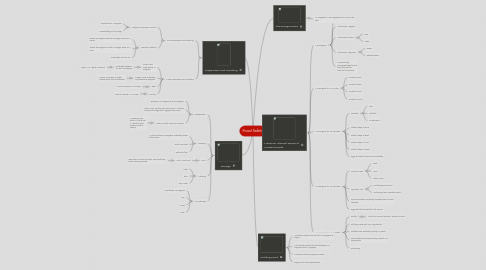
1. Storage
1.1. Refrigeration
1.1.1. Between 35 Degrees and 40 Degrees
1.1.2. Store Meat, Poultry, Fish and Dairy in Coldest Section of Fridge with Veggies Near Door
1.1.3. Order in which Items are Stored
1.1.3.1. 1.Ready-to-eat food 2. Whole fish 3. Whole meat 4. Ground meat 5. Poultry
1.2. Freezing
1.2.1. Must be below 32 Degrees Preferably down below Zero
1.2.2. Dont Overload
1.2.3. Defrost Often
1.3. FIFO
1.3.1. First In First Out
1.3.1.1. New Items In Back of Older Items with Exp. Dates Facing Forward
1.4. Labeling
1.4.1. Date
1.4.2. Item
1.4.3. Exp. Date
1.5. Dry Storage
1.5.1. Cool below 70 Degrees
1.5.2. Dry
1.5.3. Neat
1.5.4. Dark
2. Preparation and Handling
2.1. Fish Preparation and Handling
2.1.1. Fridge and Freezer Conduct
2.1.1.1. Kept below 31 Degrees
2.1.1.2. Immediately put in Fridge
2.1.2. General Handling
2.1.2.1. Below 90 Degrees can be in Danger Zone for 2 Hours
2.1.2.2. Above 90 Degrees can be in Danger Zone for 1 Hour
2.1.2.3. Preferably Held on Ice
2.2. Meat Preparation and Handling
2.2.1. Fresh Meat Kept Below 41 Degrees
2.2.1.1. Preferably between 32 and 36 degrees
2.2.1.1.1. Kept in Air Tights Container
2.2.2. Frozen Meat Preferably Kept Below 0 Degrees
2.2.2.1. Frozen in proper air tights freezer burn proof containers
2.2.3. Beef
2.2.3.1. Cook or Freeze in 3-5 Days
2.2.4. Poultry
2.2.4.1. Cook or Freeze in 1-2 Days
3. Minimum Internal Temps of Cooked Foods
3.1. 135 Degrees
3.1.1. Hot Service Fruits
3.1.2. Hot Service Veggies
3.1.3. Hot Service Grains
3.1.3.1. Rice
3.1.3.2. Pasta
3.1.4. Hot Service Legumes
3.1.4.1. Beans
3.1.4.2. Refried Beans
3.1.5. Commercially Processed Read-to-eat food that will be held for hot service
3.2. 145 Degrees for 4 Minutes
3.2.1. Roasts of Pork
3.2.2. Roasts of Beef
3.2.3. Roasts of Veal
3.2.4. Roasts of Lamb
3.3. 145 Degrees for 15 Seconds
3.3.1. Seafood
3.3.1.1. Fish
3.3.1.2. Shellfish
3.3.1.3. Crustaceans
3.3.2. Steak/Chops of Pork
3.3.3. Steak/Chops of Beef
3.3.4. Steak/Chops of Veal
3.3.5. Steak/Chops of Lamb
3.3.6. Eggs that will be served immediately
3.4. 155 Degrees for 15 Seconds
3.4.1. Ground Meat
3.4.1.1. Beef
3.4.1.2. Pork
3.4.1.3. Other Meat
3.4.2. Injected Meat
3.4.2.1. Including Brined Ham
3.4.2.2. Including Flavor-injected roasts
3.4.3. Ground Seafood including chopped and minced Seafood
3.4.4. Eggs that will be held for hot service
3.5. 165 Degrees for 15 Seconds
3.5.1. Poultry
3.5.1.1. Whole or Ground Chicken, Turkey, or Duck
3.5.2. Stuffing made with TCS Ingredients
3.5.3. Stuffed meat, seafood, poultry, or pasta
3.5.4. Dishes that include previously cooked TCS Ingredients
3.5.5. Reheating
